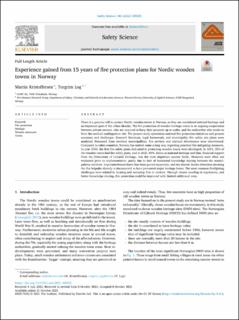| dc.contributor.author | Kristoffersen, Martin | |
| dc.contributor.author | Log, Torgrim | |
| dc.date.accessioned | 2021-11-01T14:44:12Z | |
| dc.date.available | 2021-11-01T14:44:12Z | |
| dc.date.created | 2021-10-21T18:13:54Z | |
| dc.date.issued | 2022 | |
| dc.identifier.citation | Kristoffersen, M., & Log, T. (2022). Experience gained from 15 years of fire protection plans for Nordic wooden towns in Norway. Safety Science, 146. | en_US |
| dc.identifier.issn | 0925-7535 | |
| dc.identifier.uri | https://hdl.handle.net/11250/2827018 | |
| dc.description.abstract | There is a genuine will to protect Nordic wooden towns in Norway, as they are considered national heritage and an important part of the urban identity. The fire protection of wooden heritage towns is an ongoing cooperation between private owners, who are required to keep their property up to codes, and the authorities who works to limit the residual conflagration risk. The present study systemizes national fire protection initiatives and present successes and challenges. Research literature, legal framework, and municipality fire safety site plans were analyzed. Personnel from involved municipalities, fire services and national directorates were interviewed. Compared to other countries, Norway has indeed come a long way regarding practical fire mitigating measures. In year 2000, the first fire safety plans dedicated to protecting wooden towns were developed. In 2014, 25% of the wooden towns had fire safety plans, and in 2020, 60%. Status as national heritage and thus, financial support from the Directorate of Cultural Heritage, was the most important success factor. Measures were often not evaluated prior to implementation, partly due to lack of horizontal knowledge sharing between the municipalities involved. Important lessons have thus been gained separately, and not shared. Smoke detection alarming the fire brigades directly is documented to have prevented major heritage losses. The most common firefighting challenges were related to locating and accessing fires in cavities. Through clearer wording in regulations, and better knowledge sharing, fire protection could be improved with limited additional costs. | en_US |
| dc.language.iso | eng | en_US |
| dc.publisher | Elsevier | en_US |
| dc.rights | Navngivelse 4.0 Internasjonal | * |
| dc.rights.uri | http://creativecommons.org/licenses/by/4.0/deed.no | * |
| dc.subject | Risikoreduserende tiltak | en_US |
| dc.subject | Mitigation measures | en_US |
| dc.subject | Kulturarv og kulturminner | en_US |
| dc.subject | Cultural heritage | en_US |
| dc.subject | Brannsikkerhet | en_US |
| dc.subject | Fire security | en_US |
| dc.subject | Forebyggende risikokartlegging | en_US |
| dc.subject | Predictive risc stratification | en_US |
| dc.title | Experience gained from 15 years of fire protection plans for Nordic wooden towns in Norway | en_US |
| dc.type | Peer reviewed | en_US |
| dc.type | Journal article | en_US |
| dc.description.version | publishedVersion | en_US |
| dc.rights.holder | © 2021 by the authors | en_US |
| dc.subject.nsi | VDP::Bygningsfag: 530 | en_US |
| dc.subject.nsi | VDP::Building technology: 530 | en_US |
| dc.source.pagenumber | 16 | en_US |
| dc.source.volume | 146 | en_US |
| dc.source.journal | Safety Science | en_US |
| dc.identifier.doi | 10.1016/j.ssci.2021.105535 | |
| dc.identifier.cristin | 1947652 | |
| dc.relation.project | Norges forskningsråd: 305336 | en_US |
| dc.relation.project | Norges forskningsråd: 298993 | en_US |
| cristin.ispublished | true | |
| cristin.fulltext | original | |
| cristin.qualitycode | 2 | |

